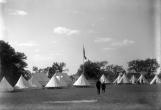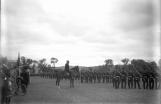1
Without any doubt the period between 1894 and 1914 was the period in the life of the Canadian Militia that saw the greatest gains, the largest numbers of men and horses being trained and the numerous other changes which contributed to the formation of individual supporting arms such as the Canadian Army Service Corp plus a number of others.Other changes occurred that did not sit well with militia units and their ingenious approaches to solving these changes are detailed to some extent. In 1894 it was determined that units could not bring bands to camp and allowances were ceased for all bands. The Hussars had brought their band to camp for 32 consecutive years before this time. Most of the band had been centered in Sackville NB for the better part of this period, so the Regiment immediately enrolled the whole band as troopers and brought them to camp anyways. This was the informal start of the 8th Hussar Band which continued to train in Sackville up until the 1980's. Due to their efforts, music continued to be used to fill the spare time of the troops.
This period did not start off well in 1894 due to disputes in Ottawa and an immediate cession to camps was issued in June of 1894 and only a few units who had started training early managed to make it to camp. However 1895 saw a complete reversal with one of the largest camps ever operated to date at Sussex with two infantry battalions, cavalry, and engineers.
Construction continued for the whole of this period, First new but temporary stables were constructed in 1895 but in the following years, construction tended to be more permanent. A caretaker house was built in 1896 followed by permanent armouries in 1901. This Armoury was for the use of the 74th Battalion and the Hussars to store and control their equipment. A windmill was constructed to pump water through underground pipes to the infantry lines. Upgrades were made to the existing rifle range on the camp but eventually a new one was necessary and a new rifle range was opened in 1906 which still exists today. This range was to see service in both World Wars. Also new and better stables had been erected during this period. The highlight of this building program was the construction of an officer's mess by the 8th Hussars called the Bungalow. This building would continue to be one of the social centers of Sussex for over 40 years.
Construction was also being noted in local training areas around the province and in 1901 an armoury was opened in Woodstock to support the training of the engineers and the artillery battery there. That building is still in use today and still houses the Woodstock Battery.
During this period of time, each consecutive camp grew in size and it began to stretch the resources of the camp. Camps were doubled and spread over summer and fall periods. This lead to much dissention as it impacted the soldiers ability to attend harvests and prepare for winter. This would not be finally resolved until 1904 when all camps from the time forward were conducted during the summer. Fall camps tended to be wet and cold leading to previously mentioned concerns about the treatment of the horses. The number of horses in camp grew each year from 395 in 1895 to just over 1000 in the summer camp of 1914 on the eve of the First World War. The numbers of soldiers topped out at just over 3400 men in July, 1914.
A number of events during this period added to the activities of the camp but none would have the impact of the outbreak of the Boer War in South Africa in 1899 and the immediate dispatch of soldiers from the area to serve there. A company of 2nd (Special Service) Battalion, 2 Royal Canadian Regiment was raised consisting of about one thousand men.
Due to this conflict, changes in weapons and other equipment continued at a steady pace. The Lee Enfield Rifle replaced the Lee Metford Rifle which had been considered too difficult for the average militiaman to master. The Lee Enfield was replaced with the Ross Rifle which was considered a more accurate weapon but it was to prove later on not to be able to withstand the effects of battle and would be scrapped part way through World War 1.
Problems encountered with harness and saddles emerged and were remedied swiftly, including quick couple harness for the artillery which allowed them to limber and unlimber the guns in less than half the time. Inadequate uniforms were solved by the use of serge for replacement uniforms which was seen as more durable. Problems with the supply of cloth, both in quality and quantity, were experienced and this was noted in the report to Parliament in 1907.
2
Church Parade (2)Circa 1910
Sussex, New Brunswick, Canada
 Credits:
Credits:New Brunswick Provincial Archives - P210-162
Annual Report, Department of Militia and Defence of the Dominion of Canada
3
Church Parade (3)Circa 1910
Sussex, New Brunswick, Canada
 Credits:
Credits:New Brunswick Provincial Archives - P210-1761
Annual Report, Department of Militia and Defence of the Dominion of Canada
4
Camp Sussex Tent CityCirca 1900
Sussex, New Brunswick, Canada
 Credits:
Credits:New Brunswick Provincial Archives - P13-140 / Bell tents - Camp Sussex
Annual Report, Department of Militia and Defence of the Dominion of Canada
5
Camp Sussex Tent LinesJuly 1900
Sussex, New Brunswick, Canada
 Credits:
Credits:New Brunswick Provincial Archives - P13-141 / Bell tents - Camp Sussex
Annual Report, Department of Militia and Defence of the Dominion of Canada
6
Infantry Mock BattlesCirca 1903
Sussex, New Brunswick, Canada
 Credits:
Credits:New Brunswick Provincial Archives - P13-148 / Sham battle - Camp Sussex
Annual Report, Department of Militia and Defence of the Dominion of Canada
7
Advancing InfantryCirca 1903
Sussex, New Brunswick, Canada
 Credits:
Credits:New Brunswick Provincial Archives - P13-152 / Troops returning from sham battle - Camp Sussex
Annual Report, Department of Militia and Defence of the Dominion of Canada
8
Officers Tent LineCirca 1903
Sussex, New Brunswick, Canada
 Credits:
Credits:New Brunswick Provincial Archives - P13-158 / Division staff at Head Quarters
Annual Report, Department of Militia and Defence of the Dominion of Canada
Crook and Marteinson, A Pictorial History of the 8th Canadian Hussars (Princess Louise's)
Ganong, AT, A Historical Outline of the Regiment
9
March PastCirca 1903
Sussex, New Brunswick, Canada
 Credits:
Credits:New Brunswick Provincial Archives - P13-166 / March Past
Annual Report, Department of Militia and Defence of the Dominion of Canada
10
The 74th Battalion (The New Brunswick Rangers)1903
Sussex, New Brunswick, Canada
 Credits:
Credits:New Brunswick Public Archives - P37-509 / No.6 Co. 74 Regt. Sussex, September 11, 1901
Kings County Historical Society
A Historical Outline, The New Brunswick Rangers
Annual Report, Department of Militia and Defence of the Dominion of Canada
11
The Guns Roll PastCirca 1903
Sussex, New Brunswick, Canada
 Credits:
Credits:New Brunswick Provincial Archives - P13-153 / Artillery in the field
Annual Report, Department of Militia and Defence of the Dominion of Canada
12
The Guns on the Firing lineCirca 1903
Sussex, New Brunswick, Canada
 Credits:
Credits:New Brunswick Provincial Archives - P13-154 / Artillery in the field
Annual Report, Department of Militia and Defence of the Dominion of Canada
13
The 8th Hussars Regiment formed up.1903
Sussex, New Brunswick, Canada
 Credits:
Credits:Association of the 8th Canadian Hussars (Princess Louise's) Inc
Annual Report, Department of Militia and Defence of the Dominion of Canada
Regimental Orders, 8th Princess Louises Hussars (1899-1906)